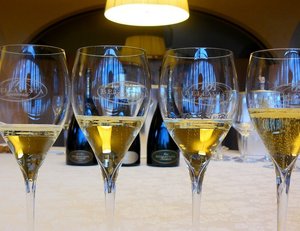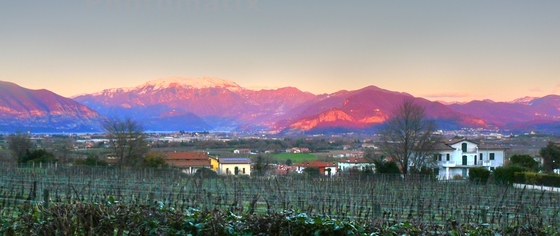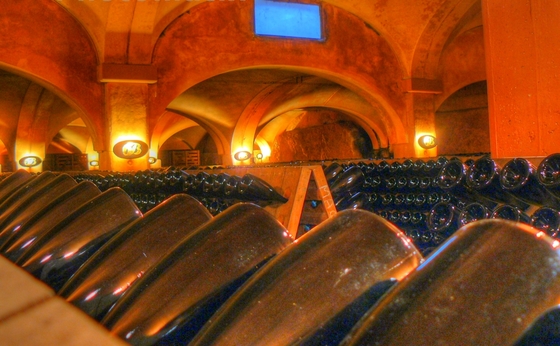BRESCIA--Across the top of the Italian boot, from Torino in the west to Trieste in the east, where the Alps meet the plain, runs one of Europe's most prosperous economic engines: Italy's high-tech, high-design, precision manufacturing industry, a mind-boggling networkof small businesses that line the A4 motorway like an unending strip mall. Further south, the mighty Po river, then farm country punctuated by the jeweled art cities of Parma, Bologia, Ferrara and Ravenna. Then, across the Apennines, the dreamworld of Tuscany and Umbria.
But before you get out of the mountains, there's the glitzy international playground (George Clooney has a house here) of the Alpine Lakes that extend their icy blue fingers toward Switzerland: famous names like Garda, Maggiore and Como, plus one less known to the rest of the world, Iseo. At the foot of the snow-capped, 6,200-foot Monte Guiglielmo, Lake Iseo has something the others don't: Italy's finest vineyards for sparkling wines.
 Chardonnay. pinot noir, pinot blanc, some 2,500 hectares (6,500 acres) of vines in all, that the growers and investors have manage to snatch from the hungry maw of industrial development.
Chardonnay. pinot noir, pinot blanc, some 2,500 hectares (6,500 acres) of vines in all, that the growers and investors have manage to snatch from the hungry maw of industrial development.
There have always been vineyards on the morainic soill of this valley, underpinnings of the glaciated hills here, but only since the early 1960s has there been an awareness of their unique potential to produce superb sparkling wines. By the 1980s, the founders of the Franciacorta winegrowers association (a dozen longstanding families) had established the boundaries of what became the Franciacorta DOCG (the highest category of Italian appellation) that would apply only to the little valley's sparkling wines. Today, 100 or so growers produce barely 10 million bottles of Franciacorta. (Sounds like a lot, but it's a drop in Champagne's bucket; Moët & Chandon alone produces 100 million bottles.)
On the label, the name Fanciacorta is meant to convey, in a single word, a wine produced under the same strict conditions as Champagne and Cava, the only other European sparkling wines produced in the traditional (that is, "Champagne") method: strict geographic boundaries, specified grape varieties (chardonnay, the two pinots), limited yields (4.5 tons per acre), secondary fermentation in the bottle, resting on the lees for a minimum period (18 to 60 months).
By contrast, Italy's best-selling sparkler, Prosecco, barely qualifies as soda pop. Enormous yields, huge production volume, carbonated in stainless steel tanks (the Charmat method). Done right, Prosecco is perfectly fine; it's hard to argue with a wine that sells some 250 million bottles a year. But it's a far cry from Franciacorta, whose aromas alone are so complex that the wine served not in flutes but in glasses wide enough to stick your nose into.
* * *
Because there's no 300-year tradition to stand in the way here, and because most of the growers are also producers, everyone's on the same side and the growers have had little opposition to writing strict rules for Franciacorta. Also helping: strong support for and early investment in the Franciacorta concept by one of Italy's leading industrial impressarios, the construction tycoon Vittorio Moretti, who founded Bellavista, today one of Franciacorta's top estates, on his family acreage. (He has also started another winery, Petra, in Tuscany.) He had the good fortune to link up with Mattia Vezzola, an enologist with a clear vision of how to use technology to achieve Franciacorta's high profile and "soul."
Franciacorta costs more than Asti Spumante or Prosecco, obviously (and more than Spanish Cava, too), but at $20 to $25 for a bottle of brut it's roughly half the price of French Champagne. Franciacorta is suited to a variety of occasions, well beyond the celebratory aperitif; during our all-too-brief visit we drank Franciacorta with freshwater fish from the nearby lakes, with meat, with dessert. They may still be cult wines, but they're well worth seeking out.
Two dozen of Franciacorta's growers export to the US, but, unfortunately, there's not a lot of wine to go around. Our next post from Franciacorta will give you some suggestons for finding the wines stateside.
Top: Franciacorta vineyards, Lake Iseo and Mt. Guiglelmo; Franciacorta tasting at Bellavista; bottom: riddling racks at Bellavista.
Our visit to Franciacorta was sponosred by the growers consortium, Consorzio per la tutela del Franciacorta.


Leave a comment